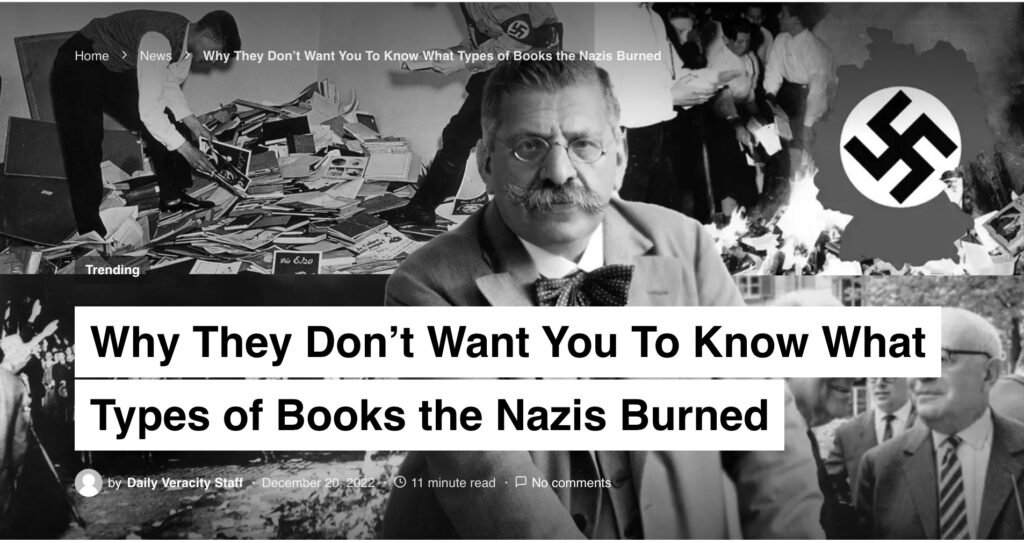Daily Veracity Staff
Randi Weingarten, the head of the American Federation of Teachers (AFT), the second-largest teachers union in the United States, recently advocated for children in schools to read “Gender Queer,” a book that contains what critics consider to be pornographic images.
Weingarten’s post advocating for Gender Queer to be included in schools’ reading lists appeared on the AFT website, where she argued that “Gender Queer is a critically important work that helps to spark understanding, awareness, and respectful dialogue about the diverse gender identities and expression of gender among young people.”
She asserts that this book will “help foster an affirming and safe learning environment for all.”
Weingarten is a lesbian, who is married to a female rabbi, Rabbi Sharon Kleinbaum. Weingarten’s marriage to Kleinbaum in 2012 was considered a milestone for the LGBT community, as it marked the first time a rabbi had officiated a same-sex wedding ceremony in the United States.
This advocacy has sparked a debate about the appropriateness of such an action and whether it is suitable for school-age children, with many on the left accusing conservatives of ‘book burning.’


The book in question, “Gender Queer,” is a graphic novel about a gender-nonconforming teen, who is struggling to find their place in the world. The book contains explicit images of nudity and sex, which have been described as “pornographic” by critics. Weingarten has defended the book, stating that it provides “critical insight” into gender identity and is important for children to be exposed to.
The book contains nude photography, descriptions of sexual acts, and explicit language that some readers may find offensive. It also contains scenes of BDSM (bondage and discipline/sadomasochism) and other forms of non-traditional sexuality.
Weingarten has also been a vocal advocate for keeping schools closed in 2020 and part of 2021. The AFT has been a major force in pushing for schools to remain closed, despite the fact that many parents and experts believe that the risks of reopening are relatively low. This decision has had devastating consequences, with millions of children missing out on vital educational opportunities.
Many critics of censoring certain books, especially when it comes to children, usually invoke the book-burning done by Nazi Germany. But what types of books were burned?

The War on Children (to watch, click here)
What Did the Nazis Burn Exactly?
The Nazi regime is known for strict censorship and suppression of ‘the arts,’ but the main target of Nazi censorship was books that contained sexually explicit material. The Nazis believed that such material was immoral and had a negative influence on German culture. As part of their ‘cultural restoration effort, they burned large numbers of books that contained any kind of sexual content.
The Nazis targeted books that contained explicit descriptions of sexual acts, as well as books that contained any kind of sexual references. This included books that contained positive portrayals of homosexuality, as well as those that contained erotic content or explicit scenes of violence. The Nazis believed that the books they burned contained “filth and degeneracy” and were a danger to German culture and morality.
As such, they conducted large-scale book burnings throughout Germany, destroying thousands of books in an effort to cleanse German culture of any kind of sexual content or references. In addition to books, the Nazis also burned other kinds of material such as posters, photographs, and films that contained sexual references or content.
A recently published book, Berlin Before the Wall, reveals the history of the city as a liberal hotbed of homosexuality before the Nazis came to power in 1933. Berlin was known as a mecca for cross-dressers, transsexuals, and those seeking male-to-female surgery.
The science of ‘transsexuality’ was founded in Berlin at the Institute of Sexual Science where the first male-to-female surgery was performed. The words ‘homosexual’ or ‘transvestite’ were coined at the institute.
This was due in part to its liberal laws, which allowed for gender reassignment surgeries as early as 1920. The book reveals that the city was also known for its vibrant LGBTQ+ nightlife and culture, featuring drag shows, cabaret, and a vibrant gay and lesbian scene. This was in stark contrast to the Nazi regime’s policies.
The book describes how the city’s LGBTQ+ culture was able to survive during World War II and the post-war period, with the help of cabaret and drag shows, as well as underground gay bars and clubs. The book also discusses the impact of the Berlin Wall, which split the city in two and divided the LGBTQ+ community.
While East Berlin became a more conservative environment, West Berlin was known as a safe haven for LGBTQ+ people. The book is a fascinating look at a unique period of history in Berlin, and reveals the city’s long history as a liberal, ‘open-minded’ haven for those seeking to express their gender identity and sexuality.

The Institute for Sexual Science, founded by Magnus Hirschfeld in 1919, was a pioneering organization that aimed to promote a better understanding of sexual health and rights. However, on May 6th, 1933, the Nazis stormed the institute and ransacked it, destroying much of the research and materials it had collected.
Magnus Hirschfeld was a Jewish German sexologist and LGBTQ activist who made significant contributions to the field of queer rights in the early 20th century. He is widely considered to be one of the most influential figures in the queer rights movement.
Hirschfeld was a prolific writer, having written several books and articles on a variety of topics related to gender and sexuality. One of his most famous publications was Berlin’s Third Sex, which he published in 1904. This book was an early look at gender variance in early 20th-century Germany, which had a thriving drag scene and a burgeoning transgender community.
The book helped to increase Hirschfeld’s profile and ultimately led to him becoming one of the most prominent LGBTQ activists in the world. Hirschfeld was also involved in writing one of the first gay characters to appear in a film, for the 1919 movie Different From the Others. His work helped to lay the groundwork for the acceptance of LGBTQ people in Germany and around the world. Hirschfeld’s activism and writings have had a lasting impact and continue to influence the modern LGBTQ rights movement.
Hirschfeld was the first to coin the term “transvestite” and was also a fierce advocate for the rights of sex workers, and for the decriminalization of contraception and abortion.
This was in direct opposition to the Nazi’s ideals of morality and their belief that homosexuality was a degenerative disease. As a result, they were determined to destroy Hirschfeld’s work, and they closed the Institute in order to suppress any further research into sexual science.
The Nazis justified their actions by claiming that the Institute was promoting “un-German” ideas. Magnus Hirschfeld was a pioneering figure in the field of sexual science, and his Institute was the first of its kind. He believed that sexual orientation was a natural phenomenon, and advocated for the rights of LGBTQ+ people.
Hirschfeld’s work and activism inspired the founder of Planned Parenthood, Margaret Sanger, who was also a passionate advocate for reproductive rights and women’s health. Sanger was highly influenced by Hirschfeld’s writings on the importance of contraception, and she used his ideas in her work.
Sanger was a strong proponent of the decriminalization of contraception and abortion, and she was an important figure in the fight leading up to the Supreme Court’s Roe v Wade decision.

Margaret Sanger, a prominent leader in the birth control movement in the early 20th century, had many Jewish allies. Her cause was one that was shared by many Jews, given their long history of oppression and the struggle to support large families in difficult economic conditions. Sanger was a passionate advocate for reproductive rights and her passion resonated with many members of the Jewish community.
In particular, Sanger had close ties with the National Council of Jewish Women (NCJW), a non-sectarian organization dedicated to social justice. NCJW supported Sanger’s efforts to bring birth control information and access to women, and many of its members actively worked to promote her cause.
The organization was also influential in lobbying for legislative action that would legalize the use of birth control. In addition to the NCJW, Sanger had the support of several Jewish doctors, including Dr. Abraham Stone, who was instrumental in setting up the first birth control clinic in the United States.
Sanger also had a close bond with Anna Lifschiz, who was a Jewish physician and an early supporter of Sanger’s work. Lifschiz was a strong advocate for women’s reproductive rights and was an important source of support for Sanger. In addition to providing moral and financial support, Lifschiz also wrote several articles in support of Sanger’s cause.
Other Jewish allies included the American Jewish Congress, which passed a resolution in 1923 expressing their support for Sanger’s work, and the American Jewish Committee, which provided funding for Sanger’s clinics. Sanger also had strong ties with Jewish philanthropist, Margaret H. Stern, who funded several of Sanger’s initiatives, including the creation of the American Birth Control League in 1921.
The support of these Jewish allies was instrumental in helping Sanger to advance her cause and to make birth control more widely available. By working together, they were able to create a powerful force that helped to shape the course of history.

The Frankfurt School
The Frankfurt School, a group of German-Jewish intellectuals in the early 20th century, has been credited as the architects of leftism.
This group of thinkers, whose members included Max Horkheimer, Theodor Adorno, Herbert Marcuse, and Walter Benjamin, sought to create a new form of critical theory that sought to understand the cause of the human condition and the oppressive forces that kept it from achieving its full potential. Through their works, these intellectuals sought to develop a critical analysis of society, culture, and politics that could be applied to later modern society.
Critical Race Theory emerged from the Frankfurt School’s work on the intersection of race and class. The theorists argue that racism is embedded in the very structures of society and that economic and academic outcomes are not merely a product of inputs from communities or idividuals. This theory has been highly influential in examining race in the United States and has been adapted to other contexts such as education and the workplace.
Gender Studies also emerged from the Frankfurt School’s critical theories. These theorists argued that gender was not a “natural” category, but rather a social construct used to maintain power dynamics between men and women. This theory has been used to examine gender inequality in many areas, such as the workplace and politics.
The Frankfurt School of thought spread to the United States in the aftermath of World War II. Many of the members of the school, including Horkheimer and Adorno, were forced to flee Nazi Germany and found their way to America. They brought their ideas with them and began teaching at universities like Columbia and Princeton.
Their ideology has had a significant influence on American intellectual life. It helped to shape the New Left movement, which sought to challenge the status quo and bring about social and political change. It also had an impact on the development of postmodernism and its focus on the power dynamics of knowledge.

Who Were the True Founders of Communism and the Architects of the Russian Revolution?
The role of Jewish intellectuals in the development of communism has been an area of significant historical interest. This is largely due to the fact that a number of the most influential figures in the early development of the ideology, such as Karl Marx and Leon Trotsky (Bronstein), were Jewish.
This had a profound impact on the way in which the ideology was expressed and developed, with Jewish values and experiences playing a major role in its evolution. Jewish intellectuals have often been viewed as playing a key role in the development of communism, due to the fact that they were often among the most educated members of their communities and had a strong sense of social justice.
This was true of both Marx and Trotsky, who were both passionate advocates for social and economic justice and sought to bring about a more equitable society.
The fact that many of the leading lights of communism were Jewish, as well as the fact that Jewish values and experiences played a significant role in its development, has had a huge impact on the way in which the ideology has been expressed and understood over the years.
It has also led to some criticism of the ideology from those who view it as being overly influenced by Jewish values, rather than being based on a universal set of principles. Nevertheless, it remains clear that Jewish intellectuals were at the forefront of the development of communism and their legacy continues to be felt today.
The Russian Revolution of 1917 was a pivotal event in history that changed the political landscape of the world. It is widely known that communists were at the forefront of the revolution, leading the charge toward a new political and social order. However, what is less well-known is that many of these communists were Jewish.

During the late 19th century, Jews in Russia were facing increasing persecution and discrimination from the Tsar’s regime. As a result, many Jews chose to find solace in the revolutionary ideologies of Marxism and anarchism. These ideologies provided a platform for Jews to fight for their rights and for a better life for their people. As the revolution gained momentum, many Jews joined the ranks of the revolutionary forces.
Jews made up a significant portion of the Bolshevik Party, including leaders such as Grigory Zinoviev, Lev Kamenev, and Yakov Sverdlov. Jews also made up a large portion of the Petrograd Soviet, a major player in the revolution. In fact, Jews comprised around half of the Soviet’s Executive Committee.
Jews were also involved in the early stages of the Bolshevik uprising, such as the storming of the Winter Palace and the establishment of the Soviet government. Jews played a significant role in the October Revolution, which led to the establishment of the first communist government in the world.
The genocides perpetrated by Jewish Russian Communists in the early 20th century are some of the most horrific and least discussed crimes of the twentieth century. From 1918 to 1921, approximately seven million people, mostly Ukrainians, were systematically murdered or exiled in what is known as the Holodomor, or the Great Famine.
The Soviet Union’s policy of “War Communism” was responsible for this tragedy. War Communism was a Soviet economic and political system that forced peasants to give up their private property and their produce to the state in exchange for a meager ration. This led to a famine in 1919-1920 in which millions of people died from starvation.
In addition to the Holodomor, Jewish Russian Communists also perpetrated the Red Terror during the Russian Civil War, which was a campaign of mass executions and deportations of those deemed to be enemies of the new Soviet state. Between 1918 and 1921, the Red Terror resulted in the deaths of hundreds of thousands of people.
The Red Terror, a period of extreme violence and repression in Soviet Russia, was perpetrated by Jewish revolutionaries who had taken power in the aftermath of the October 1917 Revolution. During this time, Bolshevik leaders such as Leon Trotsky and Grigory Zinoviev led a campaign of terror and intimidation against their perceived enemies, including those who opposed the revolution and the new communist government.
This was done with the active support of the secret police, known as the Cheka, which was led by Felix Dzerzhinsky, a Jewish revolutionary. The Red Terror was characterized by mass arrests, executions, and torture. Thousands of people were killed, and many more were sent to labor camps or exiled. Those targeted included members of the former Tsarist government, clergy, intellectuals, and other opponents of the revolution.
Joseph Stalin removed Leon Trotsky from power in the Soviet Union. Stalin had Trotsky removed from his positions in the Communist Party and the Soviet government. In 1929, Trotsky was exiled from the Soviet Union, and in 1940 he was assassinated in Mexico by an agent of the Soviet secret police.




I’m always in favor of a better vocabulary…so glad this came along…..you too can now speak Bidenese!
First vid is cool, but the second is the “lesson”:
https://choiceclips.whatfinger.com/2023/01/05/this-poor-man-and-he-is-our-president-omg-anyone-speak-bidenese/